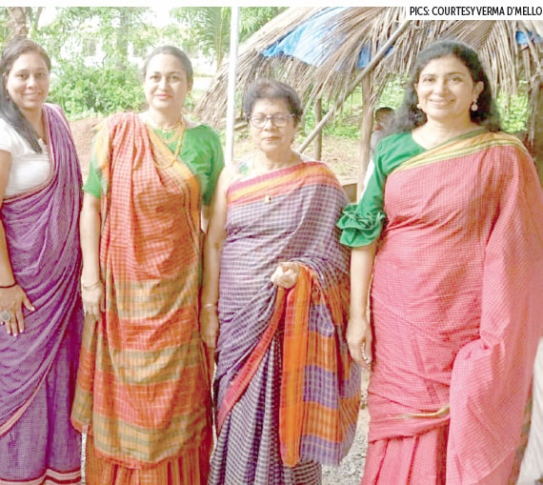
Verma D’Mello has always been a people person. Being in the fashion industry for over two decades, her collections would be incomplete without the women behind her work. In her effort to give back to society, she is training not just girls and women but even men who are interested in the fabric trade. Along with Goa Sudharop, a volunteer non-profit organization based in California since 2000, Verma recently installed the ‘Goan Kunbi Weaving Loom’, a handloom that will specialise in the weaving of the Kunbi fabric.
The idea of launching this handloom is to revive the lost Kunbi tradition and culture . During one of Verma’s trips to the USA for the World Fashion Week in Califorina, Goa Sudharap, was impressed with the presentation and agreed to be part of this handloom initiative. Since then, this project has been silently taking shape and this is the culmination of a long journey. “Kunbi fabric is part of our culture and before it vanishes, we thought we should highlight it. This will also create learning and job opportunities programs for all,” says Verma. Noted for her bridal wear in Goa, she has presented her collections at the Cannes Film and Fashion Festival for several years and was also ‘Best Red-Carpet Designer’ in 2019.
Recently, Agriculture Minister Ravi Naik said that the Geographical Indication (GI) application for Kunbi sari is under process of documentation, and the same will be submitted once weavers are trained to weave kunbi saris with a proper dobby (border), so as to claim originality. The state government is making serious efforts towards securing GI tag for the Kunbi saree. And the villagers of Orlim are also enthusiastic about this new project. “the Goa government is planning on securing GI Tag for Kunbi fabric. This initiative will give a major boost to the process. I have attempted to give the Kunbi sari a modern look but at the same time made every attempt to retain the basic essence of the fabric. Being a Goan, I have a deep respect and love towards our own native handmade organic fabric which brought a very unique identity to us. As a fashion designer, I have always been inspired by the Kunbi fabric. There is also great scope of employment and the current generation will feel proud wearing their heritage fabric,” adds Verma.
So how does a handloom work? “Handloom, the word says it all. It needs a great amount of effort and focus to understand the technique and design of the loom. It is not easy but also one who starts learning would enjoy doing it. Weaving on a handloom is a jolly process, once we gain perfection over the basic workings of the machine. It needs great coordination of the hands for pulleys and legs for paddling with the quick movement of the eyes. Yes, it needs that much effort but also we are going to make it easy by teaching them the saree designing and installation of the design into the loom,” explains Verma.
Over the years, power looms and auto looms have contributed to the handloom industry slowly dying. The training currently has 43 students but they are aiming for over 100 students. “There will be a master class for the guests. The training for the students is free of cost. Many students have been given workshops and training sessions to make them understand the Kunbi origins and its stunning special qualities. The students love the aspect of the entire procedure of making a loom and its functions. Kunbi was just a saree fabric but we are going to teach them how to make different kinds and styles of fashion clothing and accessories out of Kunbi. We are exploring more about the multi-purpose application of Kunbi and hope students would be proactive in taking it forward,” says Verma.
Kunbi making has many phases and all students wouldn’t need to learn everything at the class. Yarning to dyeing, they are trained with the awareness of the entire procedure. “Going back to hand-making and powerless loom, would help the students learn the process of evolution which can lead to better results and new trends in making and presenting Kunbi. Students with these basic skills can understand and be a part of almost in any organic fabric making to the core possibilities,” adds Verma.
The Kunbi fabric will definitely be incorporated in her fashion show but not frivolously. “I have always used it in many shows, at least to embellish or accessorise my stories on runway. The good sign is that we have many sponsors and the Goa government is also very welcoming and supportive for the Kunbi campaign. I would take all the possible opportunities to use the fabric or name to delve deeply into our own oriented society,” concluded Verma.
